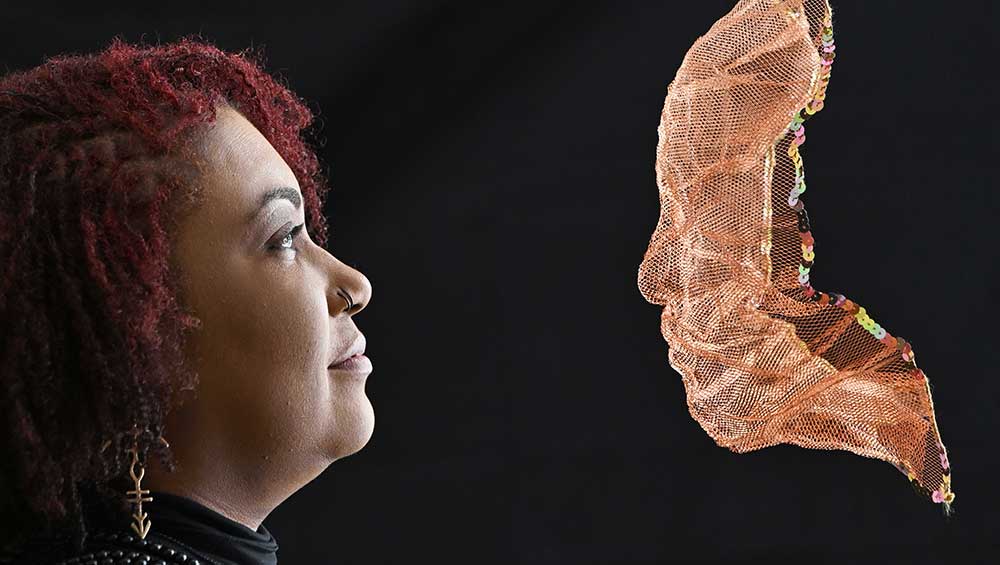
Curator Cat Dunn with Ashanti Harris' artwork Emi Ori Cse in Copper. Photo: Neil Hanna.
by JANET McKENZIE
Personal identity has for some time been a vital part of cultural exchange and art practice and forms the focus of a new touring exhibition that has opened at St Andrews Museum in Scotland. Programmed by Fife Contemporary, Crafted Selves: The Unfinished Conversation is curated by Cat Dunn and showcases the work of 13 Scotland-based artists exploring dual identities in their work. The artists – Joy Baek, Emelia Kerr Beale, Harvey Dimond, Eden Dodd, Ashanti Harris, Li Huang, Adil Iqbal, Viv Lee, Sekai Machache, Sara Pakdel-Cherry, Rae-Yen Song, Alberta Whittle and Tilda Williams-Kelly – show works in sculpture, painting, ceramics, textiles, installation, moving-image films and creative writing responses. It is an exhibition of the highest quality, and it marks a departure for the St Andrews Museum, in drawing in new audiences from the town. The University of St Andrews has always had a large international population and this year topped the Guardian’s UK university league tables. St Andrews is a 15-minute bus ride from the city of Dundee with its Victoria & Albert Museum and flourishing university with long-established international reach in culture and medical science.
Whittle, a Barbadian-Scottish visual artist, represented Scotland at the 2022 Venice Biennale, and the Zimbabwean-Scottish artist Machache will represent Zimbabwe at the 2024 Venice Biennale. Like Whittle and Machache, Hong Kong-born Lee, the Chinese-Scottish installation artist Song and Iranian-Scottish visual artist Pakdel-Cherry all have a sense of self that comes from having a cultural heritage in Scotland but also one rooted in another culture.
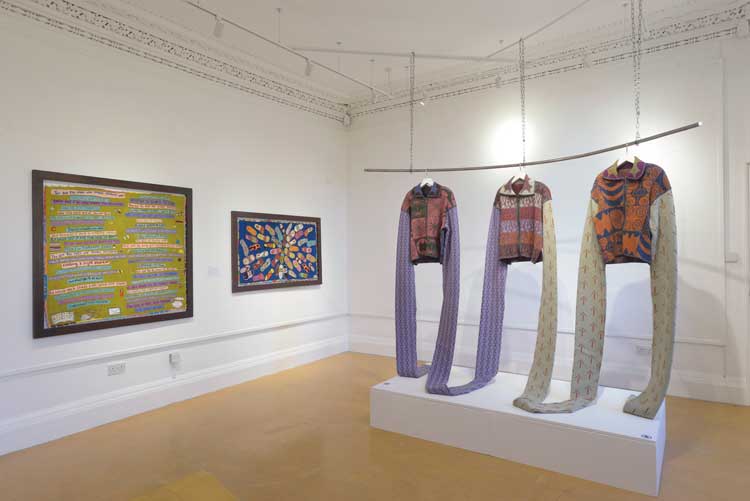
Left: Two works by Adil Iqbal; Right: Emelia Kerr Beale, trust for support, 2022. Installation view, Crafted Selves: The Unfinished Conversation, St Andrews Museum. Photo: Alan Dimmick.
The title of the show, Crafted Selves: The Unfinished Conversation, refers to the continuing dialogue between Dunn and the 13 artists, and enables visitors to engage with contemporary art practice and Scottish culture through a provocative body of work. Kate Grenyer, the director of Fife Contemporary, who conceived the exhibition that explored craft in contemporary art practice, says: “Considering the highly personal themes that the topic of [Crafted Selves] explores, it is possible to see once again the high value that visual art, craft and making have for allowing us to explore painful and challenging topics through creativity. I remain deeply moved by how many artists in this exhibition chose tightly crafted and thought-filled methodologies to help them express a personal connection to challenging cultural experiences with clarity and precision. In doing so, they reclaim the narrative, turning this into moments of pride and joy in which we can all share.”
Studio International talked to Dunn in St Andrews.
Janet McKenzie: As a Bajan-Scottish artist and now a curator, you bring your own understanding of what it means to have a dual-identity and the challenges an artist of colour may face. Can you explain how Crafted Selves came about?
CD: The director of Fife Contemporary, Kate Grenyer, was interested in a collaboration in which I would have creative freedom to stage an exhibition. My curatorial practice is influenced by indigenous and black diasporic culture, indigenous cultural practices that I use to decolonise within my practice, and further based around the traumas that come with social identity. For Crafted Selves, I started to explore craft in relation to plantocracy and enslaved bodies. As I moved through timelines, I realised that I wanted to fix the exhibition in the here and now. I had recently been at an event where I was asked: “Where are you from?” I thought: “I have to answer this question, every single day.” I spoke to a few mates who had the same experience and the idea for the exhibition was born. I wanted artists who understood the traumas associated with political aspects of dual identity, but also those artists who could still express aspects of joy.
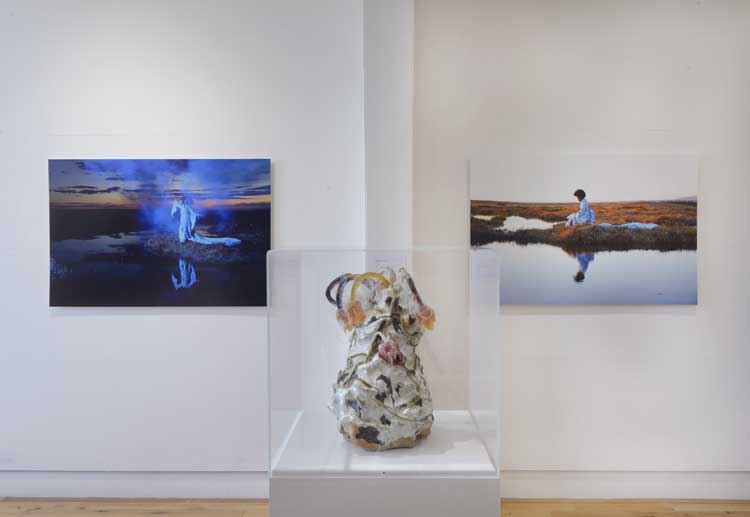
Installation view, Crafted Selves: The Unfinished Conversation, St Andrews Museum. Photo: Alan Dimmick.
JMcK: You came to Scotland 22 years ago and your curatorial work addresses the way in which Scotland has changed and how it is positioned now within the wider world. What, in your view, does Crafted Selves tell us about the individual artists and how Scottish culture has shifted in the past two decades?
CD: Scottish Culture has definitely shifted. I’ve lived in Scotland longer than everywhere else, including my birth country. When I first moved to Glasgow, I always thought not many people look like me. Now, there are mixed-raced couples walking hand in hand, and a plethora of languages and food. Scotland has become a melting pot of individuality through the diverse people and, by extension, their cultures. Yes, there are still issues to be dealt with, but I believe that it is happening slowly. I wanted to bring elements of diversity into the exhibition through artists who used their hands to craft items. The Crafted Selves exhibition shows this through the diverse mix of artists and their artworks. There is an audio loop where you can hear each artist telling you what being dual identifiable means to them, the trials, tribulations and, yes, the joy that can be found.
JMcK: Craft has strong histories in Scotland: knitting, weaving; textiles in general. What is it about these crafts that enable their makers to imbue the finished product with an urgency, tenderness and immediacy?
CD: Craft does, indeed, have a strong history within Scotland. I believe that each artwork is embedded with the energy of its maker. Who are the women (predominantly) that each artist stands on the shoulders of? It’s about telling a story through the medium of craft in such a way that someone else can understand what is being transferred or translated. As a curator, I believe that is what each artist is attempting to do, and it is why the final work has notes of urgency, tenderness and immediacy for the viewer to sense.
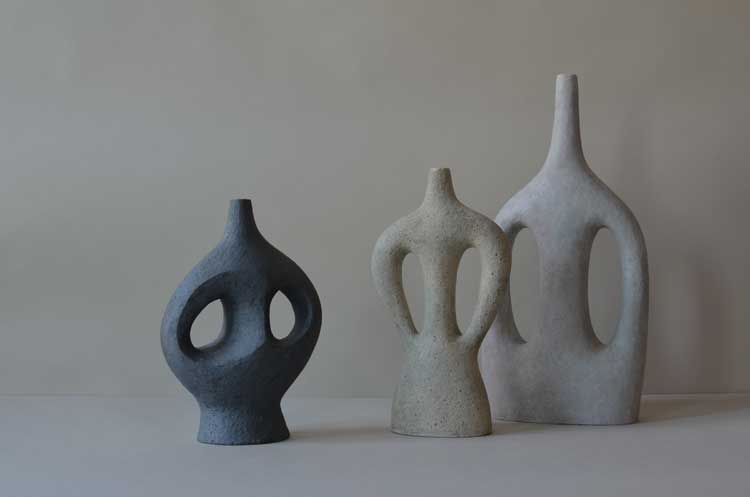
Viv Lee, collections in stoneware and ceramic.
JMcK: The Chinese-Scottish ceramicist Viv Lee refers to the feeling of being immersed in the earth in Scotland. Other artists, too, express this immersion in relation to belonging.
CD: Yes, to be able to place your hands in the earth and centre yourself is, at times, significant and is shown by more than one artist within the exhibition. Within the gallery, there is a trifecta of artworks by the Hong-Kong Chinese ceramicist Viv Lee, the South Korean-born ceramicist Joy Baek and the Zimbabwean-Scottish visual artist Sekai Machache, in a line, which was a deliberate curatorial act.
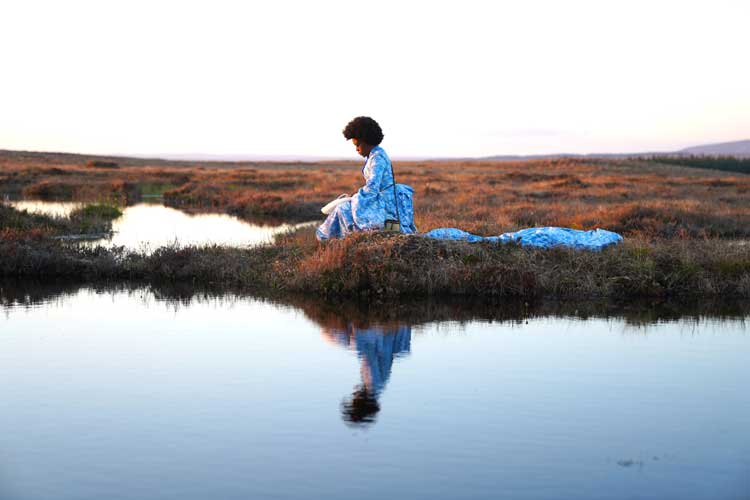
Sekai Machache, Light Divine Sky. Photo: Antanas Budvytis.
I recognised that all three artworks intersected in their anchoring in the Scottish soil/clay, either through wild clay (found in nature and not shop-bought) as Viv Lee does, or the use of the earth as muse as in the artworks of Sekai Machache. Joy Baek moulds the earth to become a household item in her elaborate ceramic jars. All three artists use their knowledge and understanding of the Scottish soil to situate themselves, perhaps unknowingly, within Scotland.
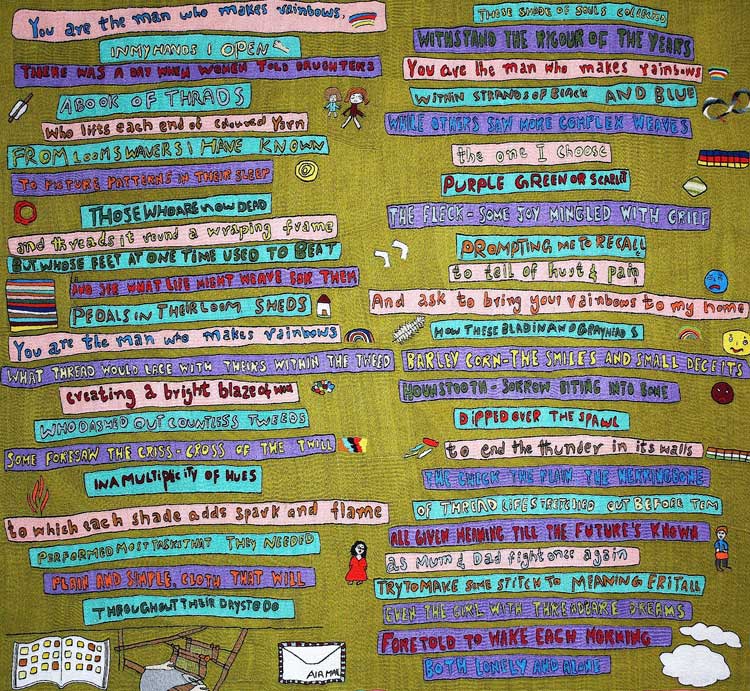
Adil Iqbal, Weaving Songs, 2012. Hand embroidery on calico.
JMcK: The wide range of expressions from sculptural ceramics to film, including the stunning embroideries by Adil Iqbal made between Pakistan and Scotland and Rae-Yen Song’s sculpture/installation, showcase an exciting range of art practice. How did you choose the final artists for the exhibition?
CD: I was interested in “curating with” artists, and the exhibition was informed through constant conversation and studio visits, even during installation. I was looking for artists and, by extension, artworks that could show not just the difficulty of having a politicised dual identity (racial, sexual or a disability). I was also interested in artists who experience the highly political question: “Where are you from?” but had found a way to navigate that question. I started with about 50 artists in my head and on paper. I was interested in artists finding that line where they are comfortable, but also in showing that innate joy though having a geographical heritage, sexuality, a disability, or an otherness, as seen by others within society, which adds another layer to how one is viewed.
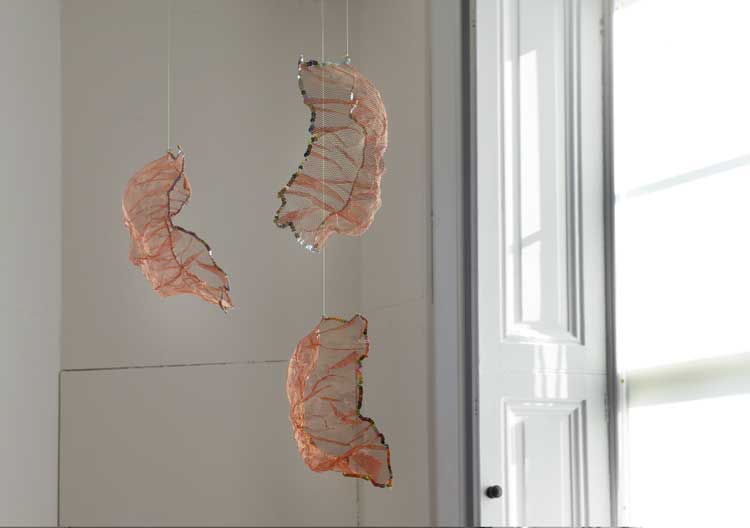
Ashanti Harris, Emi Ori Cse in Copper, as part of The Skeleton of a Name, 2019. Installation view, Crafted Selves: The Unfinished Conversation, St Andrews Museum. Photo: Alan Dimmick.
JMcK: Does the emphasis on craft empower the focus on cultures historically? There is so much information, for example, referred to in works such as Ashanti Harris’s ethereal masks.
CD: The emphasis on craft does empower the focus on cultural history. Ashanti Harris’s work explores the movement of people, ideas and things and the wider social, cultural and historical implications of these movements. Her trio of masks, Emi Ori Cse, refers to the three selves in Yoruba thought. Emi is the breath imported by the supreme being. It is the part of the self that is alive and has the automatic will to continue being alive. Ori is the inner head or the inner deity. It is the part of you that considers things, and it is where your morals and ethics come into play. Cse is your strife or struggle. It is the part that drives you forward and the part that actualises the will of the Ori. In Yoruba theory, the three selves are connected but exist separately within one being. The installation in Crafted Selves, draws on Yoruba theory and builds parallels between Ochun and the journey that Orichá culture has taken to the Caribbean, with references to masquerade and the concept of the mask.
Ceramicist Joy Baek uses materials whose exterior features change in response to time, such as latex and gelatine. This method highlights her interest in visualising the concept of being pliable and rigid simultaneously, which emerged from her belief that the virtue of using artworks to chart our lives allows for gaps and spaces we can fill with actions, thoughts and conversations. Her artwork addresses unspoken social issues of “otherness”, in turn eliciting audiences to associate with their stories and emotions.
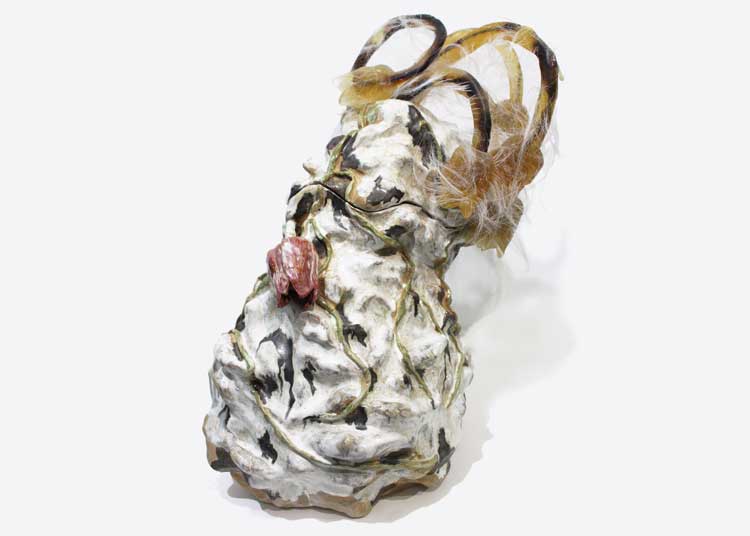
Joy Baek, Nothing Edible, Everything Sensible.
Baek’s research has evolved from the narratives of a specific target group, the elderly prostitutes in Korea (the so-called Bacchus Ladies), to the precarity of the elders with a focus on housing issues and occupational aspects. While elaborating on the precarity of the elders, she has sought to manifest their resilience as parents by borrowing the imagery of the symbolic flower Pulsatilla Koreana (known as the grandmother flower) from Korean folklore that highlights the sacrifice and unconditional love of an elderly mother for her daughters. Baek’s work seeks to highlight sociocultural issues in Korean society, specifically the lives of minorities and socially excluded people.
JMcK: You have not limited the exploration of dual identities to race.
CD: We all have multiple identities – wife, mother, sister, daughter, etc. I was investigating dual identity through a political lens, which included transgender and disability. I wanted to give these artists a platform to show their work, which is equally essential to the conversation.
JMcK: Can you explain the significance and importance of the powerful photographic works of the Iranian-Scottish multimedia artist and activist Sara Pakdel-Cherry?
CD: Sara Pakdel-Cherry’s art practice is based on her experiences as a Persian woman who hopes to educate the public on these issues, while illuminating the robust feminine heritage of ancient Persia for the women of all generations in Iran. The artworks are such an essential piece of visual art. Siah means black in the Farsi language, so the title of her film, Kafan-e Sia, is a pejorative reference to the black chador. The suspended chadors in Siah 1 and 11 are Sara’s attempt to make the viewer navigate the obstacles Iranian women face.
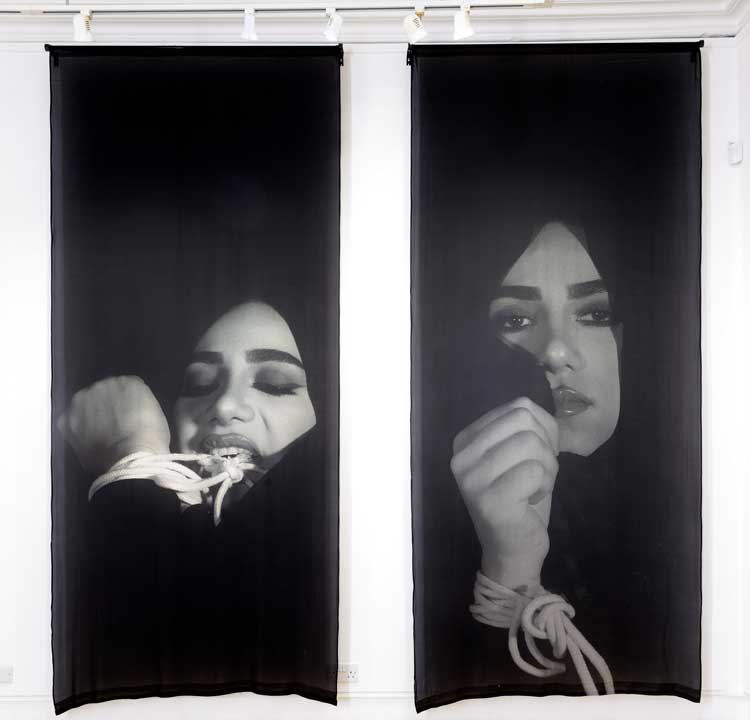
Sara Pakdel-Cherry, Siah 1 and 2, 2022. Installation view, Crafted Selves: The Unfinished Conversation, St Andrews Museum. Photo: Alan Dimmick.
She says it very well in the audio loop as she describes the feeling of not being seen or someone knowing nothing about her, but instantly putting her in a box based on her aesthetic while living in Scotland. It was a vital element of the exhibition and gave an insight into an aspect of social identity not readily seen by the outside world.
JMcK: The exhibition is made up of disparate materials and skills, histories and references. What did you look for in the artists and their respective craft methodologies? You have been keen to highlight joy through the creative process, not just the struggle?
CD: As someone with a dual identity, I know how hard it is not to be angry when asked: “Where are you from? Why are you here? Did you go to school here? So, what brings you here?” It is an ever-constant verbiage where you are expected to qualify your existence within a place. I knew that would show in the artwork. Still, I wanted the medium of craft as seen through the gaze of geographical heritage, as seen through otherness, as seen through those within a politicised marginalised community inclusive of sexuality and disability. That is what I looked for in each studio visit conversation. What artists were working on that could tell this story, this narrative in such a way that the audience would understand the harm being caused and the pride each artist had in their craft and in their identity of being Scottish. It is an essential exhibition if people will look, read and listen. As a curator, I first see the story, the narrative and the people. The objects are secondary. I wanted to curate with artists fearless in blending both identities to create the narrative thread throughout the exhibition.
• Crafted Selves – The Unfinished Conversation, curated by Cat Dunn, is at St Andrews Museum, Kinburn Park, St Andrews, until 24 February. It will then travel to Kirkcaldy Galleries, War Memorial Gardens, Kirkcaldy, from 23 March to 12 May 2024.
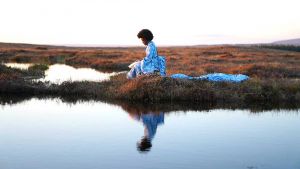 Scottish Women Artists: 250 Years of Challenging Perception
Scottish Women Artists: 250 Years of Challenging Perception
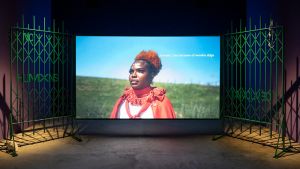 Alberta Whittle: Create Dangerously
Alberta Whittle: Create Dangerously
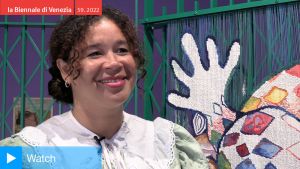 Alberta Whittle: Deep Dive (Pause) Uncoiling Memory – Venice Biennale 2022
Alberta Whittle: Deep Dive (Pause) Uncoiling Memory – Venice Biennale 2022